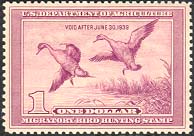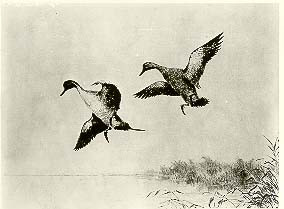

Back to RW5 Back to the Federal Index Home
A LITTLE HISTORY ON THE 5TH (1938-39) DUCK STAMP ARTIST


Roland H. Clark loved to combine his work with his favorite pastime by making sketching-hunting areas along the east coast. It has been said that he would often see a bird and be torn between shooting it and sketching it, and as a result would sometimes lose both the bird and the drawing in a moment of indecision. He did capture enough birds on paper, however, to establish his reputation as an artist as well as a sportsman.
Roland Clark was born on April 2, 1874 in New Rochelle, New York. His parents were Henry Walker Clark, a lawyer, and Fanny Elizabeth (Hunt) Clark. He studied under tutors at private schools in New York City and with H. Carroll Beckwith at the Art Students League. When he was young, he enjoyed many sports including fishing, horseback riding, and sailing. His greatest pleasure, however, was hunting waterfowl in the marshes around Long Island Sound.
When he was 26 years old, Mr. Clard was married to Ann Byrd, the daughter of Richard Corbin Byrd, a planter in Gloucester, Virginia. The couple had three children. The family lived for 22 years in Gloucester on Mobjack Bay, an offshoot of luck in the oyster trading business for a while, but the area had so many great opportunities to offer a wildfowl artist that he could not permit himself to be diverted for long. Oysters may have been better on the plate, but they simply didn't look as good on canvas as ducks did.
Mr. Clark was particularly well known for his etchings of game birds such as ducks, geese, woodcock and quail. In all, he did some 500 etchings using sketches made from life. Many of these were exhibited in one-man shows in New York and other cities. Some were purchased for the Library of Congress in Washington, D.C. Others were used as illustrations in books he wrote.
Mr. Clark wrote a total of four books. His own illustrations appear in all of them. The first book, appearing in a limited edition of 500 copies in 1931, was entitled Stray Shots. It told the story of his hunting experiences and was illustrated with 13 of his original dry-point etchings. Further reminiscences of hunting trips were contained in Gunner's Dawn, which he produced in 1937. In 1938, reproductions of 70 of his etchings appeared in Roland Clark's Etchings. Another collection of stories written and illustrated by Mr. Clark, entitled Pot Luck, came out in 1945.
Mr. Clark was a member of Ducks Unlimited, Inc. and a charter member of the American Sporting Artists.
On April 13, 1957, he died at age 83 in Norwalk Hospital, Norwalk, Connecticut.
---------------THE ART---------------
Pintails is from an etching which originally had five birds. The original plate was cut down and one bird rubbed out leaving two birds as shown. It was hand pulled, printed on off-white paper in browned black ink. Each print was hand signed in pencil and unnumbered. The image size is 6 7/8"x11'.
---------------THE STAMP---------------
Pintails...Engraved by the Bureau of Engraving from an original etching. Printed in light violet ink. The stamp sold for one dollar. Postal records show 1,002,715 stamps sold. First day of sale was July 1, 1938.
Most of the information contained above is from the book Federal Duck Stamp Story, Fifty Years of Excellence, by Laurence F. Jonson; Alexander & Co. It is used here with permission from the author. For more information on this book, please click here.